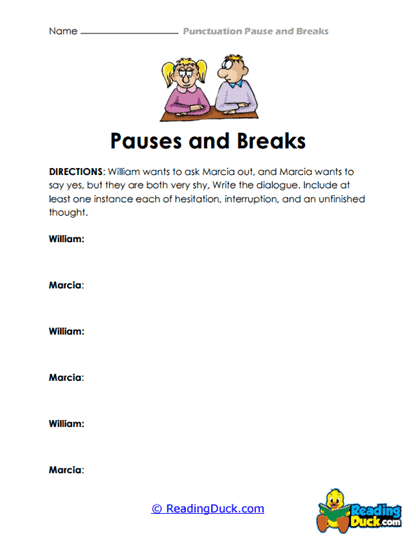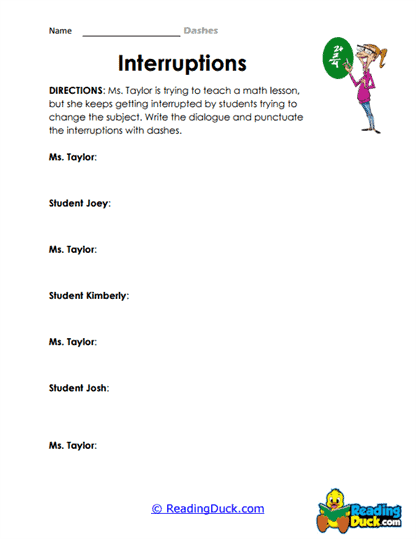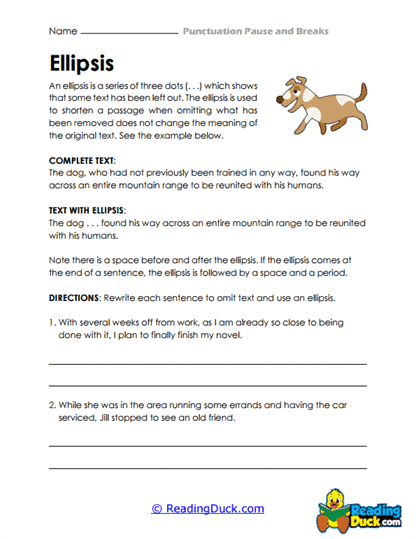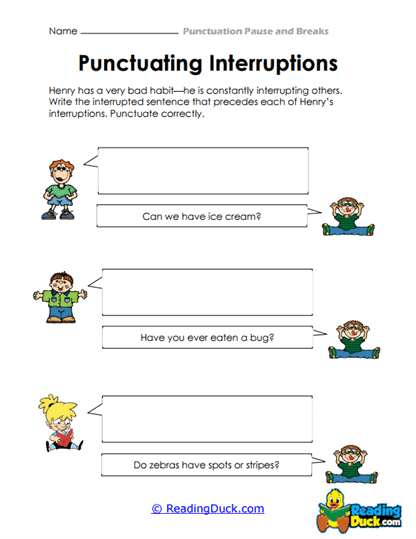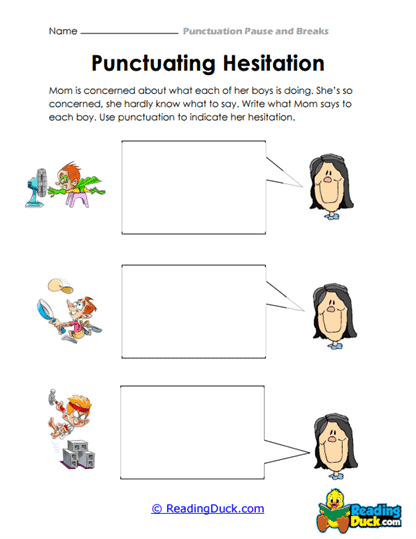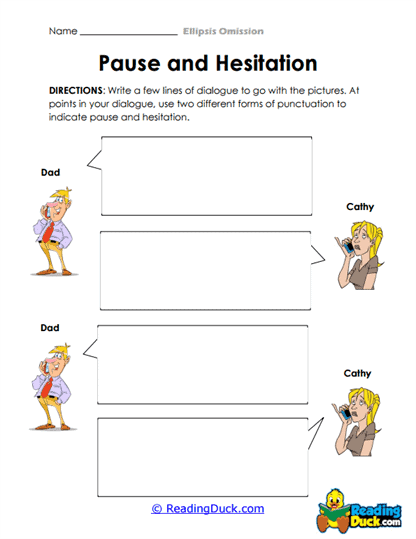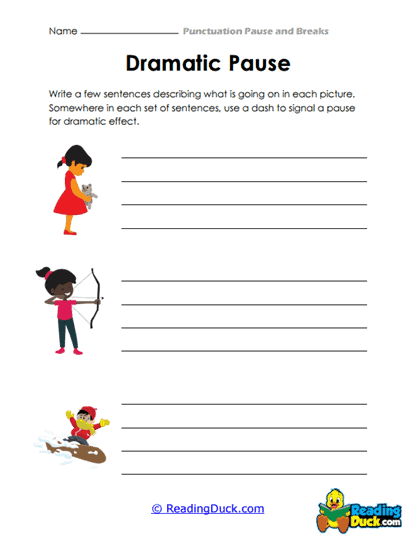Pauses and Breaks Worksheets
About Our Pauses and Breaks Worksheets
The Pauses and Breaks Worksheets collection falls under the Punctuation category within the Skills section, designed to guide students in understanding the fundamental role that punctuation plays in creating pauses and breaks in written text. This collection focuses on teaching students how to use punctuation marks like commas, periods, semicolons, and colons to structure sentences effectively and control the flow of ideas. Mastering these skills allows students to improve both their reading comprehension and their ability to write with clarity and precision.
The worksheets in this collection are presented in PDF format, making them easy to view, download, and print. This flexibility is particularly useful for teachers and parents alike, allowing for seamless integration into various learning environments. Each worksheet also includes a downloadable answer key, enabling students to review their work and understand where improvements can be made, fostering independent learning and mastery of the topic.
Understanding Pauses and Breaks in Writing
Pauses and breaks in writing are achieved through the use of specific punctuation marks. These marks create separation between ideas, control pacing, and clarify meaning. Without proper punctuation, written language becomes difficult to understand, leading to confusion and miscommunication. Learning how to effectively create pauses and breaks is an essential skill for students to develop as they grow into competent writers and readers.
Let’s dive into the different elements that contribute to pauses and breaks in writing:
The Purpose of Pauses and Breaks: Pauses and breaks serve multiple functions in writing, but their primary purpose is to give structure to language. These moments of separation between words and ideas mirror the way we speak, where natural pauses help listeners understand what is being said. In writing, punctuation marks fill this role, guiding the reader’s eye through the text.
Common Punctuation Marks for Pauses and Breaks: Several punctuation marks create pauses and breaks in writing, each with its own specific function. Understanding when and how to use these marks is crucial for developing strong literacy skills.
-
- Comma (,): The comma is one of the most commonly used punctuation marks to create a short pause between clauses or items in a list. It often separates independent clauses joined by a conjunction or is used after introductory elements in a sentence. For example:
- After the rain stopped, we went outside to play.
- I bought apples, bananas, and oranges from the market.
- Period (.): A period marks the end of a complete thought or sentence. It creates a full stop, signaling to the reader that one idea has concluded before moving on to the next. For instance:
- She finished her homework.
- The sun set beyond the mountains.
- Semicolon (;): The semicolon offers a pause that is longer than a comma but shorter than a period. It connects closely related independent clauses or separates items in a complex list. For example:
- He wanted to go for a walk; she preferred to stay home.
- The festival had music, art, and food stalls; games, rides, and face painting.
- Colon (:): A colon introduces additional information, lists, or clarifications. It creates a pause that prepares the reader for what comes next. For instance:
- She had one goal: to win the race.
- Here’s what you need: a pencil, a notebook, and a ruler.
- Comma (,): The comma is one of the most commonly used punctuation marks to create a short pause between clauses or items in a list. It often separates independent clauses joined by a conjunction or is used after introductory elements in a sentence. For example:
The Impact of Pauses and Breaks on Meaning: Without pauses and breaks, written language becomes monotonous and difficult to interpret. These punctuation marks bring rhythm to writing, help emphasize certain points, and ensure that complex ideas are delivered clearly. Students who understand the role of punctuation in creating pauses and breaks can write more effectively, making their thoughts easier to follow.
Various Uses of Pauses and Breaks in Writing
Pauses and breaks through punctuation play several important roles in conveying meaning and structure in writing. Let’s explore the different ways punctuation creates these pauses and breaks, and how they influence the clarity and flow of a text.
- Breaking Up Long Sentences: In longer sentences, punctuation is essential to prevent run-on ideas that overwhelm the reader. For instance, commas and semicolons are used to divide independent clauses into manageable segments. Consider this example:
- I love reading, but sometimes I struggle to find time; however, I always make sure to read at least one chapter before bed.
In this case, commas and a semicolon are used to break up the sentence, making it easier to read without losing meaning.
- Indicating a Change in Thought or Tone: Pauses often signal a shift in tone or a new idea. Colons and semicolons are particularly useful for this purpose, as they guide the reader through transitions in meaning. For instance:
- He couldn’t decide what to do: stay and face the consequences, or leave and never look back.
- Clarifying Lists and Complex Information: Commas and semicolons help structure lists and complex sentences by clearly delineating each item or idea. For example:
- The team was made up of professionals from various fields: engineers, designers, marketers, and writers.
This use of punctuation prevents confusion by clearly separating each element.
- The team was made up of professionals from various fields: engineers, designers, marketers, and writers.
- Emphasizing Important Information: Punctuation can be used to emphasize critical information in a text. For instance, using a colon before an important point or explanation adds weight to the following statement.
- There’s only one thing I know for sure: this journey will change our lives.
The Role of Pauses and Breaks in Literacy Development
Learning how to properly create pauses and breaks using punctuation marks plays an important role in developing students’ literacy skills. By mastering these punctuation rules, students become more proficient readers, writers, and even speakers.
- Improved Reading Fluency: Understanding how punctuation marks create pauses in a sentence helps students read with better rhythm and flow. They can pause at the appropriate times, making the text easier to understand. This skill is crucial for developing reading comprehension, especially in longer and more complex passages.
- Enhanced Writing Clarity: Pauses and breaks allow students to structure their writing more effectively, ensuring that their ideas are communicated clearly. As students practice punctuation, they learn how to avoid run-on sentences, add emphasis where needed, and create smooth transitions between thoughts.
- Better Speaking and Listening Skills: When students recognize how punctuation affects pauses in written language, they become more aware of pauses in speech as well. This skill translates into improved public speaking and listening abilities, as they learn to emphasize key points and take natural breaks in conversation.
Engaging Activities to Reinforce Pauses and Breaks
Educators can introduce a variety of activities to help students better understand and apply pauses and breaks in their writing. These activities are suitable for students in grades 3 through 8, making learning punctuation engaging and interactive.
- Punctuation Rewrite: In this activity, students are given a paragraph without punctuation and must insert the correct punctuation marks to create appropriate pauses and breaks. This helps reinforce their understanding of how punctuation controls the flow of text.
- Commas and Semicolons Practice: Students are presented with sentences where they must choose between a comma or semicolon to create the correct pause. This activity encourages critical thinking about which punctuation mark best suits the context.
- Read-Aloud Punctuation Game: In a classroom setting, students can take turns reading aloud from a passage. As they encounter different punctuation marks, they must pause appropriately, using periods for full stops and commas for shorter pauses. This game helps students understand how punctuation translates into spoken language.
- Create Your Own Sentences: Students can write their own sentences or paragraphs, using various punctuation marks to create pauses and breaks. They then share these sentences with the class, explaining why they chose certain punctuation marks and how they contribute to meaning.
The Importance of Pauses and Breaks in Writing
Pauses and breaks, created by proper punctuation, are vital for students to master as part of their literacy education. They allow for more effective communication, both in writing and in speech, by controlling the flow of ideas, adding emphasis, and preventing confusion.
The Pauses and Breaks Worksheets collection offers a structured approach to teaching this essential skill. By practicing with these worksheets, students not only improve their punctuation abilities but also become more fluent readers and writers. Ultimately, understanding how to use punctuation for pauses and breaks helps students communicate their ideas more clearly and confidently.
